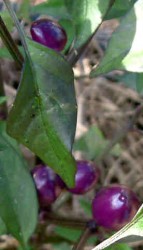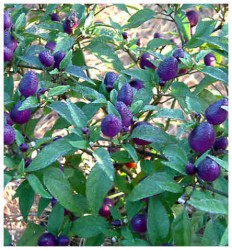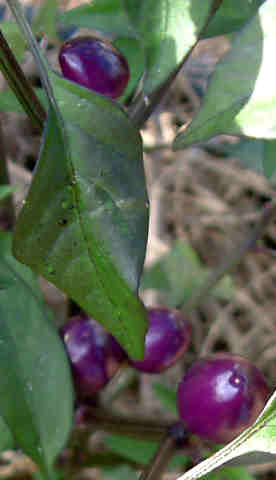Pretty Purple Pepper in the Garden
Pretty Purple Pepper is not only a variety name, but an accurate description of the plant and its fruit! Let’s talk a little about growing this wonderful pepper variety in the garden.
How Does it Look?
 It’s really hard to capture with a photo how lovely both the plant and the peppers are! The stems are a deep purple-maroon color, and the leaves have a violet sheen to them (which I can’t seem to capture). And the peppers — they are a gorgeous, glowing purple.
It’s really hard to capture with a photo how lovely both the plant and the peppers are! The stems are a deep purple-maroon color, and the leaves have a violet sheen to them (which I can’t seem to capture). And the peppers — they are a gorgeous, glowing purple.
This pepper has been quite hardy in my garden. It’s faced a near-freeze with grace, and is thriving in a 3-gallon container. I drop by it at least once a day because it’s a feast for my eyes.
(You can click on the photo for a larger image.)
Germinating the Seeds
I find that germinating seeds for this pepper to be easy. Even in a cooler temperature than normal, the plant came up within 10 days. I imagine that if I used a heat mat, that would shorten to 5-7 days.
I germinated this particular plant at cooler-than-normal temperatures as an experiment. Pretty Purple Pepper sprouted well, but the other seeds had a hard time, and most didn’t germinate at all.
(Here’s more information about germinating hot pepper seeds, if you need a few tips.)
Container Growing
I mentioned that I am currently growing this plant in a 3-gallon container, and it is thriving. While it would do better in the ground, it’s quite suitable for a lovely container plant on a patio. Not only is the plant pleasing to look at but it also has purple-and-white flowers. When the plant has flowers and peppers at the same time, it’s a sight to behold!
Other Hints for Pretty Purple Pepper
As I mentioned, this plant has had some tough conditions. Not only has it faced temperatures in the 30’s, but it’s also faced extended periods of high winds. The weather has been dry, and sometimes the soil isn’t as damp as I’m sure the plant would like. Through all this, Pretty Purple Pepper has sailed on without a problem.
What About Eating Them?
You can certainly eat these peppers, but they are quite hot — my guess is around 40,000 Scoville Units. I don’t eat a lot of them, because they are so lovely on the plant. But I reccomend them  in stir-fries and also for a vinegar pepper. And although I haven’t tried them as such, I imagine they would be good pickled.
I like Pretty Purple Pepper, and it has an ongoing spot in my garden. I hope you like it too!

Update
Here’s another photo just a couple weeks later of the same plant!
Germinating Pepper Seeds
Germinating pepper seeds can be a wee bit frustrating at first, mainly because it takes so long for the seeds to germinate. But once you have done it a few times, it’s pretty easy.
Why should you try germinating pepper seeds, instead of just buying plants at your local garden center? One reason is because the selection at your garden center is very likely limited. At best you’ll find 10 pepper varieties, more often less than that.
Usually the gorgeous ornamental-appearing peppers don’t show up in the garden center; these have to be grown from seeds. Two wonderful varieties that come immediately to my mind are Explosive Ember and Sweet Pickle.
Pepper Germination Rates
First of all, don’t expect a 100% seed germination rate from your pepper seeds. While you just might get 100%, in my experience in growing many, many varieties, 75% is more the norm. So I plant 25% more seeds than I need, and if they all germinate and thrive, I can sell or give away the extras.
Germination rates vary according to how long ago the seeds were harvested, as well as how the seeds have been stored. Generally, you want to use pepper seeds within 2 years, but they can germinate long after that time, too.
For example, I have some 10-year-old seeds that I planted a week ago, and I fully expect that some will germinate. I just planted a lot extra, because I knew the germination rate was going to be low. However, some of these seeds are rare varieties, so they are worth trying.
I tend to buy my pepper seeds online, but I’ve been known to pick up a pack at the garden shop from time to time. Either way, you don’t know for sure how old those seeds are. Always plant extra.
Germinating Pepper Seeds – Warmth and Humidity
When germinating your pepper seeds, the two most important things are heat and humidity. Peppers like plenty of warmth, and germinate best at soil temperatures of 80 to 85 degrees.
While those seeds are sitting in the warm soil, they need to be kept damp, but not wet. They need the moisture to soften the seed coats, so the plants can be born (so to speak). I like to use a windowsill greenhouse when germinating pepper seeds; the top of the greenhouse keeps in the humidity. And a bonus is that these little mini-greenhouses are inexpensive, so you can have lots for many windowsills.
However, if you live in a cooler climate, you may want to use a heat mat under your peppers to be germinated.  Please don’t use a household heating pad; that could be dangerous. Instead, get one that’s waterproof and made for keeping seeds and seedlings warm.
If you are planting pepper seeds directly outside, wait until the soil temperature has reached at least 65 degrees and that they get full sun, to heat the soil even more. Remember to keep the soil damp, but not wet.
That’s it for now! If you want to read more about seed starting for peppers, read my posts on seed starting part 1 and seed starting part 2. Enjoy!
